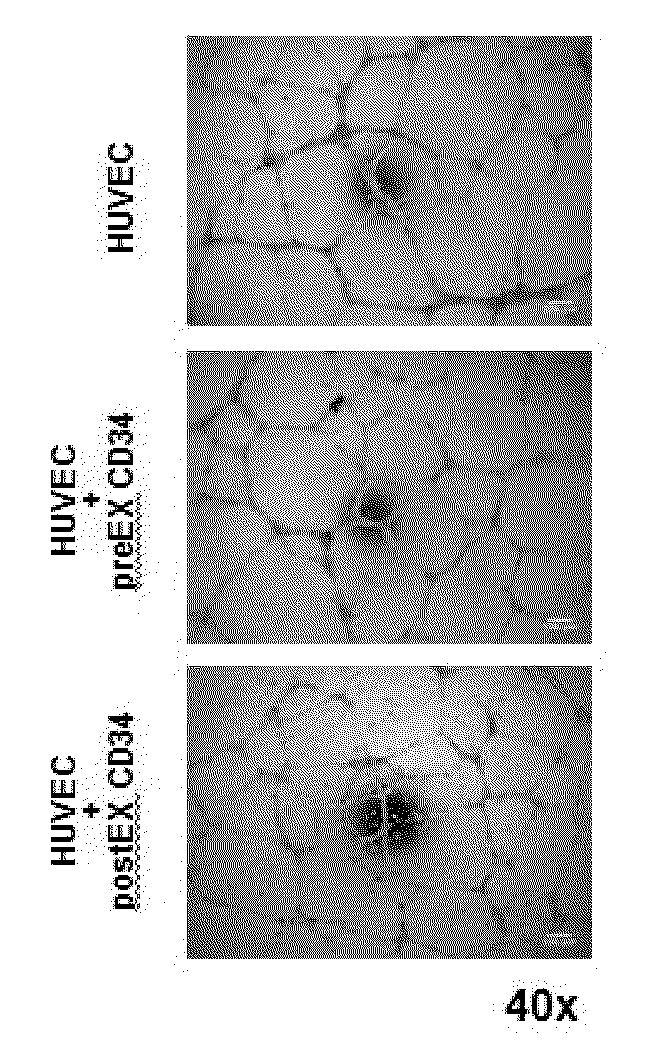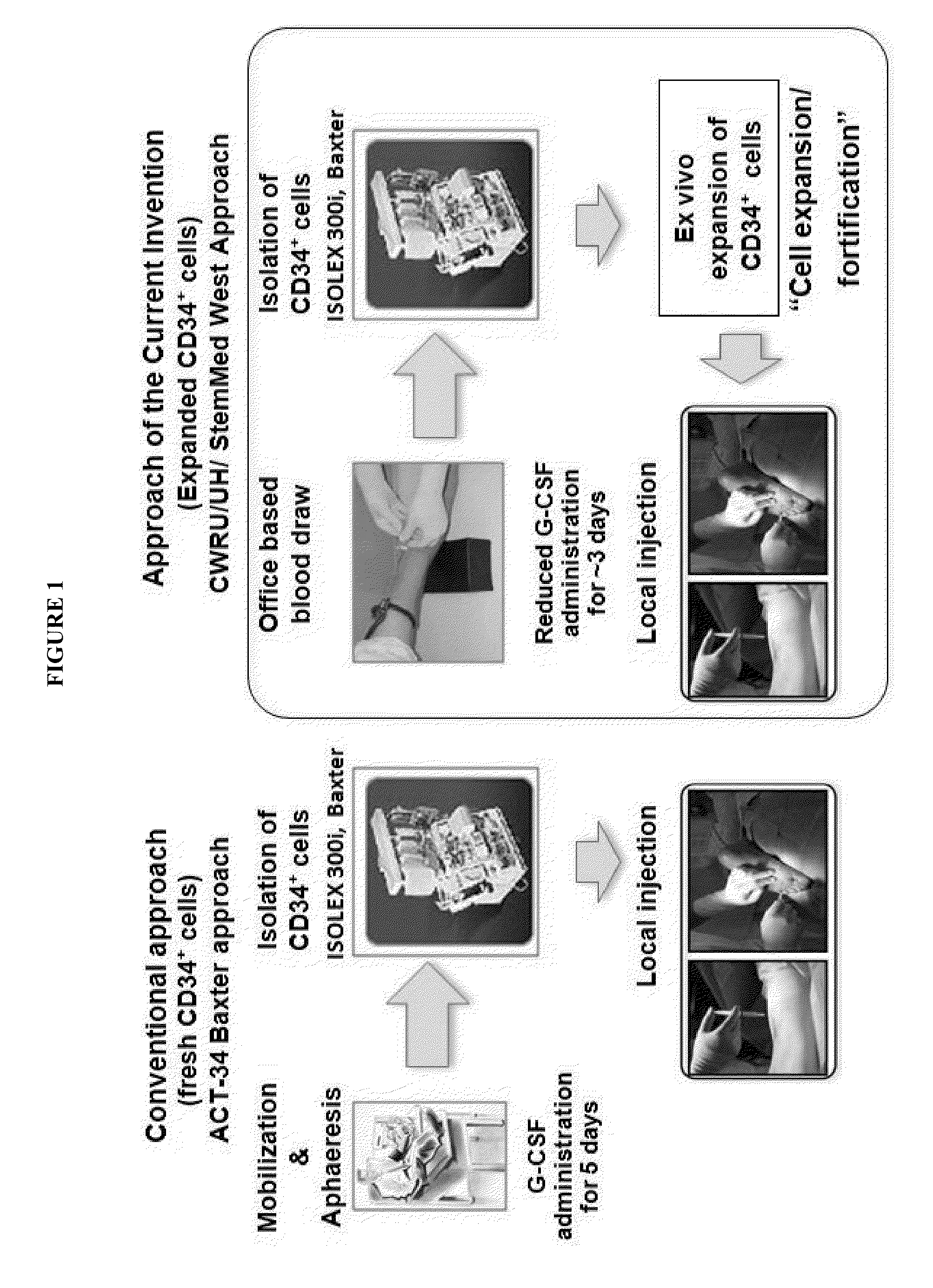Method For Amplification And Functional Enhancment Of Blood Derived Progenitor Cells Using A Closed Culture System
a technology culture systems, which is applied in the field of amplification and functional enhancment of blood derived progenitor cells using a closed culture system, can solve the problems of inability to effectively and efficiently carry out repetitive cell transplantation therapy, inability to effectively and effectively treat acute illnesses such as stroke, heart attack, stroke, etc., and achieves efficient expansion of cd-34+, improved angiogenic potential in vivo, and improved
- Summary
- Abstract
- Description
- Claims
- Application Information
AI Technical Summary
Benefits of technology
Problems solved by technology
Method used
Image
Examples
example 1
[0065]The study hypothesis was that CD34+ cells could be expanded with fortification of angiogenic potential using the current invention (StemMed West) approach and final cell product could promote therapeutic angiogenesis in mouse hind limb ischemia (HLI) compared with fresh CD34+ cells (control) and phosphate buffered saline (PBS). To confirm this hypothesis, first we used umbilical cord blood CD34+ cells.
[0066]CD34+ cells were expanded using the methods and kits of the current invention (StemMed West system) maintaining their CD34-positivity around 45% (FIGS. 3A and B). Although, there was no significant difference between our expansion method (5 cytokines) and 4-cytokine method without VEGF in cell amplification and maintenance of CD34-positivity, expression of miR-210, pro-angiogenic microRNA, was significantly up regulated in expanded CD34+ cells with our method (FIG. 3C). In addition, in vitro tube formation assay showed significant increase of the number of branch points in ...
example 2
[0069]Following the umbilical cord blood CD34+ cell experiment, we used granulocyte colony-stimulating factor (G-CSF) mobilized adult peripheral blood CD34+ cells (GMCD34+ cells) to confirm our hypothesis described in EXAMPLE 1. This mPB-CD34+ cells are used in the current clinical trial of CD34+ cell therapy for critical limb ischemia. Therefore, we chose this fraction, although the umbilical cord blood CD34+ cells are potential cell candidate because of their higher therapeutic potential.
[0070]The GMCD34+ cells were expanded using the methods and kits of the current invention (StemMed West system) maintaining their CD34-positivity around 40% (FIGS. 6A and B). In vitro tube formation assay showed significant increase of the number of branch points in the postEX GMCD34 group compared with the HUVEC and preEX GMCD34 groups (FIGS. 6C and D).
[0071]For in vivo study to confirm therapeutic potential of cells as well as umbilical cord blood CD34+ cells, HLI was induced by ligation of femo...
example 3
[0075]For further application of our method, we cultured human adult mononuclear cells (MNCs) and mobilized MNCs (mMNCs) with our expansion media and characterized cultured cells (FIG. 11). To isolate MNCs is extremely easier and less cost method compared with CD34+ cell isolation. Then, once MNCs amplification fortifying angiogenic potential with our media was confirmed, this will be a good alternative for clinical application.
[0076]As a result of 3-day MNC culture, total MNCs and CD34+ cells were not expanded, however, CD3+ / CD31+ / CXCR4+ cells, known as “angiogenic T cells”, were significantly expanded (FIG. 12 and FIG. 13). Gene expression analysis showed significant up regulations of angiopoietin-2 and miR-210 (FIG. 14). After 7 days culture of mMNCs, we could expand CD34+ cells about 3-fold in number, although total mMNCs number was decreased (FIG. 15).
PUM
| Property | Measurement | Unit |
|---|---|---|
| volume | aaaaa | aaaaa |
| volume | aaaaa | aaaaa |
| transforming growth factor β | aaaaa | aaaaa |
Abstract
Description
Claims
Application Information
 Login to View More
Login to View More - R&D
- Intellectual Property
- Life Sciences
- Materials
- Tech Scout
- Unparalleled Data Quality
- Higher Quality Content
- 60% Fewer Hallucinations
Browse by: Latest US Patents, China's latest patents, Technical Efficacy Thesaurus, Application Domain, Technology Topic, Popular Technical Reports.
© 2025 PatSnap. All rights reserved.Legal|Privacy policy|Modern Slavery Act Transparency Statement|Sitemap|About US| Contact US: help@patsnap.com



